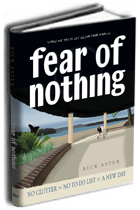Ask the average person what happens to most of their stuff, and they’ll tell you they use it up and wear it out. That actually doesn’t happen nearly as often as we think it does. One reason we think we wear out our stuff is that we give ourselves credit for wearing things out when we didn’t really. If we want to be more realistic about it, there is a difference to be seen between wearing something out through repeated use, and allowing it to decay through lack of use and the passage of time.
I experienced this distinction this summer with a pair of sandals. They actually fell apart while I was wearing them. Did I wear them out? It might seem so, but in fact, I wore them only a few dozen times, not nearly enough to wear them out. No, they were weakened not from heavy use, but from the passage of time and the effects of warm and cold weather. I had had them for ten years, long enough for the fabric and the glue to weaken to the point where, when I finally did try to use them, they crumbled quickly.
It often works out this way, that you save your stuff for a long time, only to be rewarded with a little bit of use. In economic terms, that is not a favorable exchange. It is better to throw something away than to store it for so long that its usefulness fades away, whether through decay, obsolescence, or some other reason.



No comments:
Post a Comment